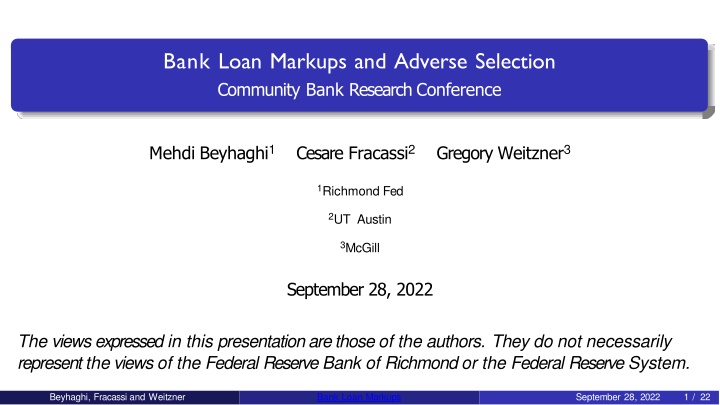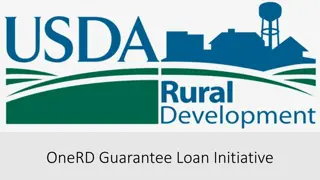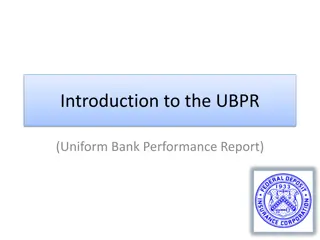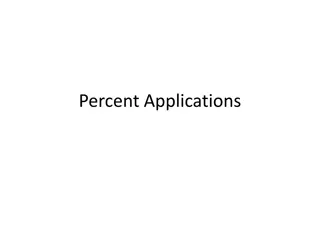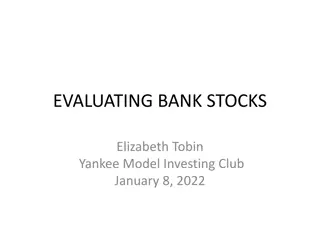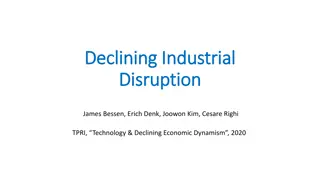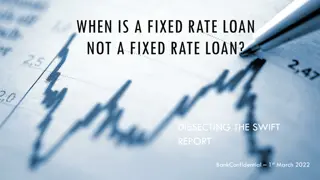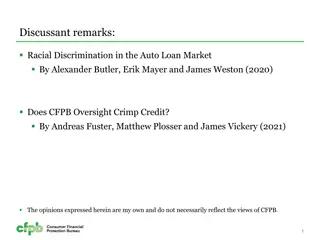Bank Loan Markups and Adverse Selection: Market Concentration Analysis
This research presentation by Beyhaghi, Fracassi, and Weitzner explores the impact of market concentration on bank loan markups and adverse selection. It delves into how asymmetric information across lenders influences interest rates in local banking markets, shedding light on the relationship between the number of banks and interest rates. Various studies and theories are discussed regarding market concentration, pricing, and deposit rates in the context of credit markets.
Download Presentation

Please find below an Image/Link to download the presentation.
The content on the website is provided AS IS for your information and personal use only. It may not be sold, licensed, or shared on other websites without obtaining consent from the author.If you encounter any issues during the download, it is possible that the publisher has removed the file from their server.
You are allowed to download the files provided on this website for personal or commercial use, subject to the condition that they are used lawfully. All files are the property of their respective owners.
The content on the website is provided AS IS for your information and personal use only. It may not be sold, licensed, or shared on other websites without obtaining consent from the author.
E N D
Presentation Transcript
Bank Loan Markups and Adverse Selection Community Bank Research Conference Mehdi Beyhaghi1 Cesare Fracassi2 Gregory Weitzner3 1Richmond Fed 2UT Austin 3McGill September 28, 2022 The views expressed in this presentation are those of the authors. They do not necessarily represent the views of the Federal Reserve Bank of Richmond or the Federal Reserve System. Beyhaghi, Fracassi and Weitzner Bank Loan Markups September 28, 2022 1 / 22
Motivation: Fernholz and Koch (2016) - BHCs Beyhaghi, Fracassi and Weitzner Bank Loan Markups September 28, 2022 2 / 22
The Effect of Market Concentration on Prices Standard theories of competition predict higher concentration leads to higher prices Beyhaghi, Fracassi and Weitzner Bank Loan Markups September 28, 2022 3 / 22
The Effect of Market Concentration on Prices Standard theories of competition predict higher concentration leads to higher prices Many studies find that higher local market concentration leads to lower deposit rates FDIC and DOJ rely on local deposit concentration measures when reviewing mergers Beyhaghi, Fracassi and Weitzner Bank Loan Markups September 28, 2022 3 / 22
The Effect of Market Concentration on Prices Standard theories of competition predict higher concentration leads to higher prices Many studies find that higher local market concentration leads to lower deposit rates FDIC and DOJ rely on local deposit concentration measures when reviewing mergers ...but credit markets are different than deposit/typical product markets Asymmetric information: Between borrower and lender: borrowers are often better informed about their creditworthiness Across lenders: some lenders know more about certain borrowers quality than other lenders Beyhaghi, Fracassi and Weitzner Bank Loan Markups September 28, 2022 3 / 22
Market Concentration and Adverse Selection Asymmetric information across lenders can create a positive relationship between the number of banks and interest rates in local banking markets. Broecker (1990), Marquez (2002), Dell Arrichia and Marquez (2006) Beyhaghi, Fracassi and Weitzner Bank Loan Markups September 28, 2022 4 / 22
Market Concentration and Adverse Selection Asymmetric information across lenders can create a positive relationship between the number of banks and interest rates in local banking markets. Broecker (1990), Marquez (2002), Dell Arrichia and Marquez (2006) The chief financial officer of a new bank once told the author that as soon as you open your doors, every deadbeat in town lines up to try to borrow from you Shaffer (1998) In regions in which more banks operate, banks market power can increase. Banks better informed about certain borrowers can charge higher rates to those borrowers because their outside options are worse Beyhaghi, Fracassi and Weitzner Bank Loan Markups September 28, 2022 4 / 22
Market Concentration and Adverse Selection Asymmetric information across lenders can create a positive relationship between the number of banks and interest rates in local banking markets. Broecker (1990), Marquez (2002), Dell Arrichia and Marquez (2006) The chief financial officer of a new bank once told the author that as soon as you open your doors, every deadbeat in town lines up to try to borrow from you Shaffer (1998) In regions in which more banks operate, banks market power can increase. Banks better informed about certain borrowers can charge higher rates to those borrowers because their outside options are worse The relationship between market concentration and prices in credit markets is theoretically ambiguous Beyhaghi, Fracassi and Weitzner Bank Loan Markups September 28, 2022 4 / 22
Key Empirical Problem: Distinguishing Market Power from Risk Loan 1 JP Morgan 2017Q1 {x,y,z,..} St. Louis County 10 4.0% Loan 2 JP Morgan 2017Q1 {x,y,z,..} Franklin County 6 4.5% Bank Quarter Loan characteristics Location Number of Banks Interest Rate Beyhaghi, Fracassi and Weitzner Bank Loan Markups September 28, 2022 5 / 22
Key Empirical Problem: Distinguishing Market Power from Risk Loan 1 JP Morgan 2017Q1 {x,y,z,..} St. Louis County 10 4.0% Loan 2 JP Morgan 2017Q1 {x,y,z,..} Franklin County 6 4.5% Bank Quarter Loan characteristics Location Number of Banks Interest Rate Is JP Morgan charging a higher markup on Loan 2 or is Loan 2 simply riskier? Beyhaghi, Fracassi and Weitzner Bank Loan Markups September 28, 2022 5 / 22
Our Proposed Solution Loan 1 JP Morgan 2017Q1 {x,y,z,..} 1.0% 30.0% St. Louis County 10 4.0% Loan 2 JP Morgan 2017Q1 {x,y,z,..} 1.0% 30.0% Franklin County 6 4.5% Bank Quarter Loan characteristics Probability of Default Loss Given Default Location Number of Banks Interest Rate Control for the risk of the loan Can reasonably argue the 0.5% difference in interest rates not because Loan 2 is riskier Beyhaghi, Fracassi and Weitzner Bank Loan Markups September 28, 2022 6 / 22
Findings 1 Estimate loan-level markup controlling for banks private risk assessments Markup measure is unrelated to future loan performance Measure strongly related to future performance if we do not control for the risk of the loan Beyhaghi, Fracassi and Weitzner Bank Loan Markups September 28, 2022 7 / 22
Findings 1 Estimate loan-level markup controlling for banks private risk assessments Markup measure is unrelated to future loan performance Measure strongly related to future performance if we do not control for the risk of the loan 2 Higher markups in regions with more banks Beyhaghi, Fracassi and Weitzner Bank Loan Markups September 28, 2022 7 / 22
Findings 1 Estimate loan-level markup controlling for banks private risk assessments Markup measure is unrelated to future loan performance Measure strongly related to future performance if we do not control for the risk of the loan Higher markups in regions with more banks 2 Evidence of adverse selection: Markups higher for firms that stay with their existing banks Markups drop following a shock that reduces asymmetric information in local markets 3 Beyhaghi, Fracassi and Weitzner Bank Loan Markups September 28, 2022 7 / 22
Roadmap 1. Methodology and Data 2. Interest Rate Decomposition: Markup 3. Markups and Market Concentration 4. Channel Beyhaghi, Fracassi and Weitzner Bank Loan Markups September 28, 2022 8 / 22
Roadmap 1 Methodology and Data 2 Interest Rate Decomposition: Markup 3 Markups and Market Concentration 4 Channel Beyhaghi, Fracassi and Weitzner Bank Loan Markups September 28, 2022 8 / 22
Methodology: Estimating Markup Interest Rate = Marginal Cost + Markup | {z } | {z } Risk of Loan Market Power Beyhaghi, Fracassi and Weitzner Bank Loan Markups September 28, 2022 9 / 22
Methodology: Estimating Markup Interest Rate = Marginal Cost + Markup | Risk of Loan {z } | {z } Market Power We estimate marginal cost using a predictive regression with loan controls, PD and LGD We also create a baseline measure where we do not control for PD and LGD 1 We then define the markup as M-arkup = Interest Rate Inte-rest Rate 2 If M-arkup is measuring market power, it should not be related to the risk of the loan We directly test this by regressing future loan performance on M-arkup 3 Beyhaghi, Fracassi and Weitzner Bank Loan Markups September 28, 2022 9 / 22
Data Federal Reserve Y-14Q data on corporate loans over $1mm Data used to monitor banks and perform stress tests Detailed loan characteristics, loan performance and firm financials Internal bank risk assessments (PD and LGD) Internal estimates of PD and LGD must incorporate all relevant, material and available data, information and methods. A bank may utilize internal data and data from external sources. Beyhaghi, Fracassi and Weitzner Bank Loan Markups September 28, 2022 10 / 22
Data Federal Reserve Y-14Q data on corporate loans over $1mm Data used to monitor banks and perform stress tests Detailed loan characteristics, loan performance and firm financials Internal bank risk assessments (PD and LGD) Internal estimates of PD and LGD must incorporate all relevant, material and available data, information and methods. A bank may utilize internal data and data from external sources. U.S. BHCs with over $50bn in assets 85.9% of U.S. banking sector assets 70.0% of commercial and industrial loan volume Beyhaghi, Fracassi and Weitzner Bank Loan Markups September 28, 2022 10 / 22
Data Federal Reserve Y-14Q data on corporate loans over $1mm Data used to monitor banks and perform stress tests Detailed loan characteristics, loan performance and firm financials Internal bank risk assessments (PD and LGD) Internal estimates of PD and LGD must incorporate all relevant, material and available data, information and methods. A bank may utilize internal data and data from external sources. U.S. BHCs with over $50bn in assets 85.9% of U.S. banking sector assets 70.0% of commercial and industrial loan volume Quarterly sample: 2014Q4 - 2020Q3 Restrict sample to new loans Remove publicly traded firms and syndicated loans Beyhaghi, Fracassi and Weitzner Bank Loan Markups September 28, 2022 10 / 22
Summary Statistics Mean SD 10% Median 90% N Loan Characteristics Amount (million USD) Interest Rate (%) Probability of Default (%) Loss Given Default (%) Maturity (months) Non-Performance (%) Realized Default (%) 6.97 3.66 1.38 35.28 41.32 2.01 0.81 14.15 1.17 1.74 14.88 31.50 14.03 8.96 1.04 2.16 0.21 15.00 10.00 0.00 0.00 2.54 3.63 0.90 36.00 36.00 0.00 0.00 15.75 5.25 2.83 50.50 84.00 0.00 0.00 28,033 28,033 28,033 28,033 28,033 28,033 28,033 Firm Characteristics Assets (million USD) Leverage Profitability Tangibility 109.66 0.33 0.14 0.91 410.70 0.26 0.26 0.17 2.71 0.01 -0.01 0.67 20.06 0.30 0.08 1.00 175.80 0.69 0.33 1.00 28,033 27,507 28,033 27,963 Geographic Characteristics Number of Banks One Bank 10.88 0.03 5.48 0.17 3.00 0.00 11.00 0.00 18.00 0.00 28,033 28,033 Beyhaghi, Fracassi and Weitzner Bank Loan Markups September 28, 2022 11 / 22
Average Default Rates Across Interest Rate Bins 1.5 Average Realized Default (%) 1 .5 0 2.1 3 3.6 4.3 5.4 Beyhaghi, Fracassi and Weitzner Bank Loan Markups September 28, 2022 12 / 22
Average Default Rates Across PD Bins 2.5 2 Average Realized Default (%) 1.5 1 .5 0 .2 .5 .9 1.5 3.8 Beyhaghi, Fracassi and Weitzner Bank Loan Markups September 28, 2022 13 / 22
Roadmap 1 Methodology and Data 2 Interest Rate Decomposition: Markup 3 Markups and Market Concentration 4 Channel Beyhaghi, Fracassi and Weitzner Bank Loan Markups September 28, 2022 13 / 22
Risk-Adjusted Markup Does Not Predict Performance When we control for the risk of the loan, our estimate of markup does not predict future performance This result provides validity to our measure of markup Beyhaghi, Fracassi and Weitzner Bank Loan Markups September 28, 2022 14 / 22
Risk-Adjusted Markup Does Not Predict Performance When we control for the risk of the loan, our estimate of markup does not predict future performance This result provides validity to our measure of markup In contrast, markup strongly predicts future performance if we do not control for its risk Hence, banks are using private information to price their loans Beyhaghi, Fracassi and Weitzner Bank Loan Markups September 28, 2022 14 / 22
Roadmap 1 Methodology and Data 2 Interest Rate Decomposition: Markup 3 Markups and Market Concentration 4 Channel Beyhaghi, Fracassi and Weitzner Bank Loan Markups September 28, 2022 14 / 22
Markups and Market Concentration Risk-Adjusted Markup (%) (1) (2) (5) (6) (3) (4) 0.010 (4.960) Number of Banks One Bank Population Density Average Wages Bank-Quarter FE Industry-Quarter FE Loan Type FE Loan Purpose FE Firm Characteristics Observations R-squared YES YES YES YES YES 25,608 0.05 YES 27,487 0.03 YES 27,487 0.03 YES 25,610 0.03 28,033 0.00 28,033 0.01 Beyhaghi, Fracassi and Weitzner Bank Loan Markups September 28, 2022 15 / 22
Markups and Market Concentration Risk-Adjusted Markup (%) (1) (2) (3) (4) (5) (6) 0.010 (4.960) 0.011 (5.266) 0.114 (2.997) Number of Banks One Bank Population Density Average Wages Bank-Quarter FE Industry-Quarter FE Loan Type FE Loan Purpose FE Firm Characteristics Observations R-squared YES YES YES YES YES 25,608 0.05 YES 27,487 0.03 YES 27,487 0.03 YES 25,610 0.03 28,033 0.00 28,033 0.01 Beyhaghi, Fracassi and Weitzner Bank Loan Markups September 28, 2022 15 / 22
Markups and Market Concentration Risk-Adjusted Markup (%) (1) (2) (3) (4) (5) (6) 0.010 (4.960) 0.011 (5.266) 0.114 (2.997) 0.011 (4.913) 0.122 (3.134) Number of Banks One Bank Population Density Average Wages Bank-Quarter FE Industry-Quarter FE Loan Type FE Loan Purpose FE Firm Characteristics Observations R-squared YES YES YES YES YES 25,608 0.05 YES 27,487 0.03 YES 27,487 0.03 YES 25,610 0.03 28,033 0.00 28,033 0.01 Beyhaghi, Fracassi and Weitzner Bank Loan Markups September 28, 2022 15 / 22
Markups and Market Concentration Risk-Adjusted Markup (%) (1) (2) (3) (4) (5) (6) 0.010 (4.960) 0.011 (5.266) 0.114 (2.997) 0.011 (4.913) 0.122 (3.134) 0.010 (3.145) 0.127 (3.045) 0.005 (0.364) Number of Banks One Bank Population Density Average Wages Bank-Quarter FE Industry-Quarter FE Loan Type FE Loan Purpose FE Firm Characteristics Observations R-squared YES YES YES YES YES 25,608 0.05 YES 27,487 0.03 YES 27,487 0.03 YES 25,610 0.03 28,033 0.00 28,033 0.01 Beyhaghi, Fracassi and Weitzner Bank Loan Markups September 28, 2022 15 / 22
Markups and Market Concentration Risk-Adjusted Markup (%) (1) (2) (3) (4) (5) (6) 0.010 (4.960) 0.011 (5.266) 0.114 (2.997) 0.011 (4.913) 0.122 (3.134) 0.010 (3.145) 0.127 (3.045) 0.005 (0.364) 0.007 (2.188) 0.112 (2.798) -0.006 (0.331) 0.170 (2.345) Number of Banks One Bank Population Density Average Wages Bank-Quarter FE Industry-Quarter FE Loan Type FE Loan Purpose FE Firm Characteristics Observations R-squared YES YES YES YES YES 25,608 0.05 YES 27,487 0.03 YES 27,487 0.03 YES 25,610 0.03 28,033 0.00 28,033 0.01 Beyhaghi, Fracassi and Weitzner Bank Loan Markups September 28, 2022 15 / 22
Markups and Market Concentration Risk-Adjusted Markup (%) (1) (2) (3) (4) (5) (6) 0.010 (4.960) 0.011 (5.266) 0.114 (2.997) 0.011 (4.913) 0.122 (3.134) 0.010 (3.145) 0.127 (3.045) 0.005 (0.364) 0.007 (2.188) 0.112 (2.798) -0.006 (0.331) 0.170 (2.345) 0.007 (2.253) 0.119 (2.876) -0.005 (0.242) 0.214 (2.554) Number of Banks One Bank Population Density Average Wages Bank-Quarter FE Industry-Quarter FE Loan Type FE Loan Purpose FE Firm Characteristics Observations R-squared YES YES YES YES YES 25,608 0.05 YES 27,487 0.03 YES 27,487 0.03 YES 25,610 0.03 28,033 0.00 28,033 0.01 Beyhaghi, Fracassi and Weitzner Bank Loan Markups September 28, 2022 15 / 22
Number of Banks in the County and Markups Beyhaghi, Fracassi and Weitzner Bank Loan Markups September 28, 2022 16 / 22
Roadmap 1 Methodology and Data 2 Interest Rate Decomposition: Markup 3 Markups and Market Concentration 4 Channel Beyhaghi, Fracassi and Weitzner Bank Loan Markups September 28, 2022 16 / 22
Markups and Switching Banks Hold-up problem: firms face higher markups if they stay with their existing banks Common result in models of adverse selection Intuition: a bank s superior information about a particular borrower increases their market power because of adverse selection Restrict analysis to firms with multiple loans in sample Beyhaghi, Fracassi and Weitzner Bank Loan Markups September 28, 2022 17 / 22
Markups and Switching Banks Hold-up problem: firms face higher markups if they stay with their existing banks Common result in models of adverse selection Intuition: a bank s superior information about a particular borrower increases their market power because of adverse selection Restrict analysis to firms with multiple loans in sample We find that markups are about 7bps higher for firms that stay with their existing banks Beyhaghi, Fracassi and Weitzner Bank Loan Markups September 28, 2022 17 / 22
Shock To Asymmetric Information in Local Loan Markets We use capital surcharges that were imposed on global systemically important banks (GSIBs) in 2016 as a shock to asymmetric information Favara, Ivanov, and Rezende (2021) show that following the imposition of these capital surcharges, GSIBs reduced their lending relative to other banks This forced reduction in lending reduces the adverse selection problem in local markets It becomes less of a bad signal if a firm does not receive a loan from a GSIB bank Beyhaghi, Fracassi and Weitzner Bank Loan Markups September 28, 2022 18 / 22
The Effect of GSIB Capital Surcharges on Market Shares MarketShareb,t,c = 0 + 1GSIBb Postt + b,c + t + ub,t,c Beyhaghi, Fracassi and Weitzner Bank Loan Markups September 28, 2022 19 / 22
The Effect of GSIB Capital Surcharge on Markups M- - -Ul = 0 + 1GSIBb Postt + b,c + t + ub,t,c Beyhaghi, Fracassi and Weitzner Bank Loan Markups September 28, 2022 20 / 22
The Effect of GSIB Capital Surcharge on Markups Effects are concentrated among borrowers that stay with their existing banks Larger effect in counties with higher initial aggregate GSIB presence Beyhaghi, Fracassi and Weitzner Bank Loan Markups September 28, 2022 21 / 22
Conclusion In corporate loan markets, markups are lower in more concentrated local markets Estimate markups using banks private risk assessments Evidence consistent with adverse selection driving market power in local banking markets Beyhaghi, Fracassi and Weitzner Bank Loan Markups September 28, 2022 22 / 22
Conclusion In corporate loan markets, markups are lower in more concentrated local markets Estimate markups using banks private risk assessments Evidence consistent with adverse selection driving market power in local banking markets Standard methods for measuring market power may not be appropriate for loan markets Deposit markets are not subject to the same degree of asymmetric information Higher concentration does not necessarily imply more market power Our markup methodology could be useful to regulators with access to Y-14Q data Beyhaghi, Fracassi and Weitzner Bank Loan Markups September 28, 2022 22 / 22
